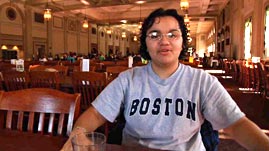Teachers' Domain - Digital Media for the Classroom and Professional Development
User: Preview

Source: Living With MyType 2:"Misty - On Eating Smart"
Learn from Misty and Tim, two teens who have diabetes, about the food choices they make to help them control their condition, in these two video segments adapted from Living With MyType2. Misty is a college student learning to adapt her dietary needs to a new environment filled with options. Tim goes grocery shopping with his mother and explains how he identifies foods as healthy or unhealthy based on their ingredients and location in the store.
Tim—Shopping Like a Pro (Video)
One problem with processed foods—which include fried fast foods and foods that may contain lots of salt, sugar, and added fats—is that the human body can have trouble digesting them. They can move through the body before they can be fully digested, leading to diarrhea. Or they can stay in the digestive system too long, causing a bloated, or full, feeling. Other signs of poor digestion include stomach pain and nausea, overtiredness, joint pain, and heartburn—a burning feeling in the chest that occurs after eating.
A diet that consists mostly of processed foods can cause long-term health problems as well. These include an increased risk of heart-related diseases, such as heart attack and stroke, and diabetes, an endocrine disorder that is a growing epidemic. There are different forms of diabetes, but type 2 diabetes is the most common, afflicting hundreds of millions of people in the world. The prevalence of type 2 diabetes has increased in recent years, corresponding to changes in lifestyle and rising rates of obesity.
After eating food, the human body breaks it down into simpler forms, such as the sugar glucose, which is used as fuel by cells. The hormone insulin helps cells process glucose into energy. A diabetic’s body does not produce enough insulin or is not able to use it properly, so glucose can't move from the blood into the body’s cells. As a result, high levels of sugar end up in the blood and cells become starved for energy. Symptoms of diabetes include fatigue, increased appetite and thirst, weight loss, blurred vision, and areas of darkened skin. Over time, diabetes can lead to serious health problems, including heart disease and damage to the eyes, kidneys, and nervous system.
Once diagnosed, the treatment for diabetes primarily consists of diet and exercise. The goal is to keep blood glucose levels from getting too high or low and to prevent disease complications. It is important to have a healthy diet full of fruits, vegetables, and whole grains, and to maintain consistency by eating balanced proportions of carbohydrates, proteins, and fats at roughly the same times each day. A diabetic should also monitor blood glucose levels by frequent testing. In addition, regular exercise improves blood flow and blood pressure, and also lowers blood glucose levels and burns calories. If diet and exercise are not enough to manage the disease, medications and insulin therapy may also be used.
 Loading Standards
Loading Standards